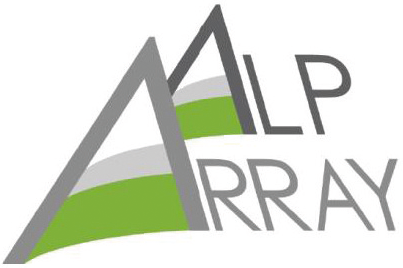B - AlpArray seismological station network (offshore)
The array comprises a network of 579 broad-band seismometers that covers the Alps for several years (end 2015–2019, white lines in Fig. 1). The target volume of this network at the scale of the orogen extends from the surface down to the base of the Mantle Transition Zone (MTZ) at ~660 km depth. The network is broken down into 278 existing, permanent broad-band seismometers of the national networks, 268 mobile land-based seismometers from a multinational pool and 33 off-shore seismometers to be deployed temporarily in the Ligurian Sea (Fig. 1b). The present German contribution to the network (Fig. 1b) includes 24 of the 33 ocean-bottom seismometers (OBS) in the Ligurian Sea (LOBSTER) and 68 land-based stations scraped together in a joint effort by 8 German universities (UNIBRA). The latter has been deployed in the central part of the Alps. From Autumn of 2017 onward, the 68 university stations will be replaced by 100 new land-based stations of DSEBRA; 32 of those stations will be deployed at sites of AlpArray partners.
Marine stations (Activity B): LOBSTER, “Ligurian Ocean-Bottom Seismology & Tectonics Research”, is the German part of the French-German program to deploy broad-band OBS stations in the Ligurian Sea. A total of 29 OBS were deployed in June 2017, 22 of which come from the German DEPAS pool and GEOMAR and 7 from the IPGP (Paris). A station spacing of < 60 km at the SW end of the AlpArray was achieved. Instrument costs and ship time for offshore deployment of broad-band OBS stations are shared by Germany and France: Station deployment was conducted from the RV Pourquoi Pas? in June 2017 and OBS recovery will be during cruise MSM-71 of RV Maria S. Merian, sailing in February of 2018. The off-shore stations in the Ligurian Sea provide information on the 3D structure of the Alps-Apennines join by capturing surface and body waves emanating from earthquakes in the Pacific area and penetrating the Alpine slabs.
Figure 1: The Alps and its forelands with locations of AlpArray network and related densified station swaths: (a) White lines delimit the international station network with 579 broad-band seismometers (red triangles – permanent national stations, white circles – AlpArray mobile stations). Purple lines - AlpArray passive seismic swaths with densified station configurations: EASI – Czech-Austria-Swiss swath, CIFALPS – China-Italy-France swath. Black lines – active seismic experiments of the 1980s and 90s, including T, the TRANSALP profile; (b) German seismometers in AlpArray network: Red-blue circles – UNIBRA later replaced by DSEBRA; Blue circles - DSEBRA; Red stars – LOBSTER; Yellow boxes - mobile swath C; Orange rectangle - swath D with densified station networks.



